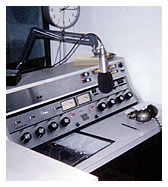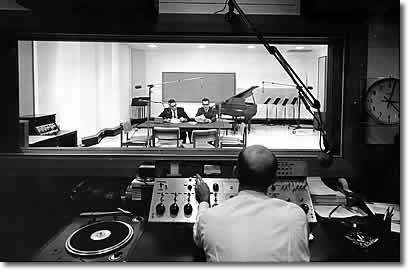
A dozen years later. This is the FM board in 1977, courtesy Kent Bernhardt.


A dozen years later. This is the FM board in 1977, courtesy Kent Bernhardt.

 |
Photo
by Fiddlin' Hank |
You’re looking at WBT-FM in 1962. This is the whole deal, except for a cabinet (not shown) that held a meager supply of stereo records. The entire staff consisted of one and one-half people: Lacy Sellers (the manager, who spent half his time doing something else) and the full-time production guy in the picture. Joe Young also helped out in production on a part time basis.
This portable home-made console was in WBT’s Studio C. Two turn-tables, one recorder, one mike and a Scotch Tape dispenser. The console was a creation by Tom Callahan, Tommy Stutts and Bill Cook. The cabinetry, all on wheels, was the handiwork of Floyd Grass, corporate woodworker.
For awhile, FM's "separate" schedule was a rebroadcast of Project 60 from a week ago, two afternoon and two evening hours per day of uninterrupted stereo music. The balance of its weekday schedule was devoted to simulcasting AM’s signal, although on weekends our four listeners could enjoy such substantive programming as classical music; contemporary drama like "The Subject Was Roses" and other plays; "An Evening at the Opera" with commentary by former Metropolitan star Norman Cordon; and the recorded plays of Shakespeare, with commentary by Charlotte College Shakespearian expert, Professor Sidney Stoval.
As no stereo microwave transmission gear existed, the tapes recorded here (by me and Joe Young) were hauled in boxes once a week to the transmitter at Spencer Mountain, 25 miles away. Joe or I would borrow Bob Covington's company station wagon, when we could get it, and zoom along the newly-opened I-85 to Gaston County. The transmitter engineers, whose leader was the kind and gentle Ralph Painter, would roll the tapes at the appointed times, and keep the program logs.
At the other end of Studio C was a somewhat grander recording station—with a real, store-bought console—used daily by Clyde McLean to produce Project 60, and by other announcers to record commercials and shows. At that setup there were these two Magnecorder tape machines, the sorriest brand on the planet, whose record heads had to be realigned about every three hours.
Through the glass was the much smaller Studio A, the "live" studio—where from time to time old time radio was actually committed. Ty Boyd, Pat Lee, Bill Curry, Jim Patterson, Doug Mayes, or whoever, would sit and speak to an adoring world, while an engineer in the "master control" room facing them would switch on their mikes, carts and turntables. Meanwhile one or two other engineers held the fort at the AM transmitter site down on Nation's Ford Road. Labor intensive, huh? Every hour at :59 the duty announcer would read a minute of Eastern Airlines' "Flight Facts," from a Teletyped update of all Eastern flights arriving or departing Charlotte's airport in the next hour, or not. (Charlotte was a major hub for Eastern Airlines in those days, and had its main reservations center out on Park Road near the current site of SouthPark mall.)
Each night for a few weeks in October of '62, during the Cuban missile crisis, just before midnight signoff, a man we presumed to be from the CIA would show up with a 30-minute tape in Russian that was broadcast from Studio A. It was aimed at the Soviet troops in Cuba, which our night-time AM signal covered very nicely. It hardly occurred to us that the Soviets could very well have locked onto our signal and lobbed a nice fat nuclear-tipped missile right up our transmitter.
Beyond the live studio was the largest one of all, Studio B, which held a grand piano used by musical groups, such as black quartets who appeared either taped or live on the paid religion shows on Sunday Morning. "B" is where Bob Bean would deliver the 6:00-615pm news every afternoon. And adjacent to Studio B was the production room, populated by the likes of Jim Davis, Monroe Brinson, John Burchett, Sid Linton, Jerry Hancock, and others as the years went by. Early on, an old transcription recorder sat in the production room, a relic from another era. It had seen its last service in the '40s, no doubt, making acetate disk recordings of old CBS shows to be DB'd (delayed broadcast). Finally it occurred to someone that the spooky old cobweb-covered machine had really, really outlived its usefulness, and one day it vanished.
The last wooly mammoth of old radio broadcasting was the CBS Radio Network. By this point they were down mostly to broadcasting news (four or five minutes, on the hour), but on Sunday evening they were still sending Gunsmoke and Yours Truly, Johnny Dollar down the line, which we actually carried), and a few other entertainment shows through the week, which we didn't. One of these was a radio dance remote from some hotel nightspot (Announcer, with hand cupped to ear: "From the Flamenco Room high atop the Fairmont Hotel...").
Sidebar: Once, in the late '60s, John Burchett and I visited CBS in New York and actually went along on one of those dance remotes. It was at Roseland, the famous dance palace of the 1920s, still in business. In the show windows out front were enshrined the dusty old dancing shoes of George Raft (about a size 6) and Lucille LeSeur (later Joan Crawford). As we watched from the elevated broadcast position, the vast, dimly-lit dance floor with hundreds of silver-haired couples looked like a meadow filled with sheep, all swaying in unison in the moonlight. Without a doubt, to every soul on that floor, it was 1943 again and there were bluebirds over the white cliffs of Dover.
The announcer for that dance remote at Roseland was CBS' Dave Campbell. A few years before, he had been a salesman for a paper company in Charlotte. Dave had had some radio experience, so WBT-FM hired him to do an air shift on Saturday afternoons. One day he said, "I'm gonna see if I can get a job announcing at CBS." Yeah, right. Our jaws dropped when a few weeks later CBS hired him.
 |
From Jim Scancarelli collection |
Back to the station in a box. In a couple of years, after stereo microwave links were developed, it was decided to take FM to a whole new level, with a full-time schedule of separate programming. We added a salesman to the staff, Walker Gregory, who'd sell the time and I'd write the copy and produce the spots.
We abandoned the little box and moved into a brand new studio/control facility upstairs in the "JP" wing. We could have done with a small announce booth, but what they built was a studio you could roller skate in (see photo). And, of course, it was furnished with a Bosendorfer natural-walnut baby grand that must have cost a fortune. If it was ever used for anything official, I don't remember it. But it came in real handy when Loonis McGlohan, the company's music director, wanted to noodle around on the keyboard during his lunch hour. It's probably still sitting there, gathering dust.